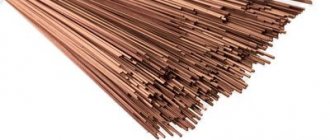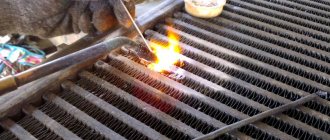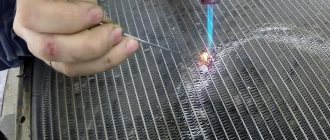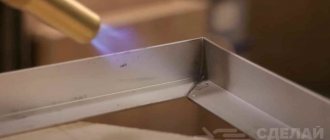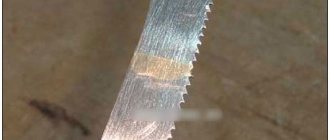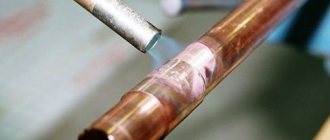Five thousand years ago, minters from Egypt discovered a new type of joining metals using the soldering method. The essence of the method is to create a connection between different metals by filling the seams with solder, which is a molten material with a melting point lower than that of the parts of the product being connected. Unlike steel, it is more expedient to connect copper parts by soldering rather than welding. This is especially important if you have to work with thin-walled copper pipes, which are widely used in heating, plumbing, gas and refrigeration systems. Even a beginner can handle this kind of work.
Features of copper pipes
The chemical composition used in the production of copper pipes consists of 99% copper, but minor impurities of tin, iron, antimony, and lead are allowed.
Copper pipes are hard (not annealed) and soft (annealed). During manufacturing, through machining, the copper material loses its natural ductility.
This property can be restored by annealing the metal, that is, heating it to 600-700 degrees and then cooling it under natural conditions. As a result of such actions, the copper pipe receives some technological advantages over solid copper. Of course, a soft pipe loses in strength, but it is much superior in ductility, which increases the value of its elongation at break by 40-60%. This means that the soft pipe can be easily bent without fear of breaking. Due to the plastic deformation of copper, such pipes can prevent the water supply from rupturing if it accidentally freezes.
Copper pipes have the following advantages:
- durability of operation;
- strength;
- ability to be easily processed;
- are not afraid of ultraviolet radiation;
- withstands the highest possible temperatures;
- operate safely under high pressure;
- have bactericidal properties;
- do not corrode;
- have high thermal conductivity and a smooth surface.
Of course, the higher cost of copper compared to other modern materials can be attributed to its disadvantages, but soldering technology allows you to save on fittings.
What physical and chemical processes is soldering based on?
Brazed copper pipes
When soldering, the solder, when heated, first softens and then turns into a liquid state. This temperature range is called the solder melting zone. During soldering, the parts to be joined are heated, but not brought to a liquid state. The process of fusion of liquid solder occurs when the temperature of the solder becomes higher than its melting point. This is the so-called operating temperature. The molten solder wets the metal being joined, spreads and eliminates gaps between the copper pipes being connected.
Soldering time, or the period from heating the soldering site until the solder transitions to a solid state and crystallizes, averages 4-5 minutes. It is also necessary that the soldering tool generates enough heat so that within 2 minutes of heating the molten solder reacts with the surfaces being joined. In this case, the flux and parts will not overheat.
During soldering, the solder enters into physical and chemical interactions with the copper pipes being connected. This ability is called solderability.
The very nature of all physical and chemical processes occurring during soldering is very complex and not fully understood. However, the entire soldering procedure can be briefly described as follows. The preparatory stages in forming a joint can be considered heating, melting and wetting, or contact of liquid metal with the heated surface of the part. As a result of wetting a solid metal with a liquid, the surface of the solid metal is replaced by the liquid-solid interface. In it, solution-diffusion, diffusion and chemical processes of interaction take place between liquid solder and the parts being connected (copper pipes). As a result, all gaps are filled and a strong connection is formed between the solder and the parts. The solder then crystallizes during cooling and a seam is formed.
Soldering methods for copper parts
Permanent connection of pipes at industrial facilities, as well as copper soldering at home, is carried out using two methods:
- High-temperature method - used on pipelines operated at high temperatures and under heavy load. Solder melting by this method occurs at a temperature of 600-900℃.
- Low temperature method - used for domestic systems. When using soft solder, the heating of the soldering area reaches 450℃, and for hard solder - more than 450℃.
Solder for soldering copper
Copper joining is a complex technological process that allows for a permanent connection.
The development of suburban housing construction has led to the fact that in utility networks everyone uses pipes made of non-ferrous metals and their alloys. In order for the pipeline system to operate smoothly, and most importantly safely, it is necessary to ensure a high-quality connection between the elements of the pipeline fittings. Such connections are made using soldering.
Solder for soldering copper
Tools and accessories
Of course, to solder copper pipes with your own hands as standard, you can use many elements that are easy to find in your own household supplies. In extreme cases, you will have to purchase special devices to perform the soldering process. So, to carry out high-quality installation of copper products you may need:
- A manual pipe cutter that will allow you to get a strictly perpendicular pipe cut.
- A chamfering device is used to remove various burrs and round off the cut area.
- A pipe expander will help in many situations to do without the use of fittings. For soldering, you need to increase the diameter of one end of the pipe in order to insert another workpiece there.
- Brushes and pipe cleaners will help clean the pipe soldering area from oxide.
- To increase the safety of work, you need to install a fire reflector (reflector) on the burner nozzle, which will help protect flammable materials located near the work site. This will prevent heat loss and ensure uniform heating of the pipe.
- A gas torch is the main tool for soldering copper pipes. There are several types of burners - from high-performance models to household devices.
Solder Connection Capabilities
In gas, water, and coolant supply systems, pipes with thin walls are often installed.
Such pipelines are easier to solder than to weld. True, the process is relatively easy when working with pure copper or its alloys containing zinc, tin, lead, and other chemical elements resistant to oxidation. Even if oxides form, they are easily removed.
If the alloys contain titanium, aluminum, silicon, chromium, then the products formed as a result of oxidation are difficult to remove. In most cases, alloys of the first type are used for the production of pipes.
Copper pipes can be joined and repaired by soldering using hard or soft solders. Each method has its own characteristics. Brazing of copper is carried out at high temperatures. In this case, a burner is used.
A person with experience in such work can perform soldering well without burning the metal.
Copper Connection Materials
The entire technological process of soldering copper tubes with a gas torch can be carried out using flux and copper solder, as well as with or without the use of fittings.
Flux and solder paste
Flux for soldering copper pipes is of great importance for the formation of a high-quality connecting seam. It can be low temperature with activity up to 450 ℃, and high temperature - more than 450 ℃.
The use of flux is necessary in the following cases:
- high-quality cleaning of the surface of the connected pipes from oxides;
- protecting the connection site from oxygen contained in the air;
- increasing the adhesion of solder to the metal surface;
- improving the process of solder spreading.
Today there are the following types of fluxes:
- activated;
- acidic;
- non-acidic;
- anti-corrosion.
Solder paste is a thick mass consisting of flux, small particles of solder and special additives. This composition is often used in industrial enterprises when soldering radio components on printed circuit boards. The paste form is very convenient for applying to small parts.
Types of solders
The connection of copper and its alloys can be made by both low-temperature and high-temperature soldering. There are many soft and hard materials that can provide ideal fastening of metal parts.
The use of solders with a low melting point makes it possible to solder parts under conditions that have little effect on the strength of copper, but at the same time the connecting seam has worse mechanical parameters. Solders for high-temperature joints increase the strength of the joint between metals, but require certain skills to prevent burning of copper.
Features of soldering with flux
When connecting copper pipes using flux, soldering can be done at temperatures up to 450⁰. During low-temperature soldering, the base metal is not deformed, the seam is smooth and uniform, since the flux wets the surface well and penetrates the capillaries. Thanks to it, the solder is distributed evenly, and there are no pores or slag inclusions in the seam.
During the soldering process of high-temperature joints, the flux spreads over the seam and closes it from contact with air, preventing oxidation.
The flux should be selected according to the solder. It should melt before the solder itself and provide a good connection at the capillary level.
Copper pipe soldering technology
The entire technological process of connecting parts made of copper material can be divided into preparatory operations and the actual stage of creating a strong joint.
Basic connection operations using a torch:
- It is most convenient to cut a pipe using a pipe cutter. To do this, the tool is installed on the workpiece so that the cutting roller coincides with the cutting line. Next, the screw is clamped and a cut is made by rotating it around the axis of the pipe. After every two revolutions, the rotation of the screw presses the cutter towards the pipe. You can cut metal with an ordinary hand hacksaw, but it is very difficult to achieve a perpendicular cut.
- After cutting, you need to remove the outer and inner edges. The outer chamfer is removed to facilitate assembly, but the inner chamfer may resist the flow of water or gas. There are special devices for carrying out this type of operation. Sometimes they are built directly into the pipe cutter, and sometimes they act as a separate device.
- The next step is to clean the mating parts of the part from oxides. The outer surface can be easily cleaned with fine abrasive paper or a special device with a hole framed by a steel brush. To clean the inner edge, brushes, mesh or sandpaper are used, screwed onto any pin of the appropriate diameter. After cleaning the surface to a shine, you need to remove any remaining abrasive, which significantly reduces the quality of soldering.
- After cleaning, it is necessary to apply flux to the surface. The paste-like composition is applied with a brush to the outer part of the inserted pipe. After this, the parts are immediately connected to avoid debris.
- During assembly, the mating parts must be rotated relative to each other in order to achieve complete distribution of the flux over the surface. Then excess flux is removed with a cotton rag, and the parts are fixed in a position convenient for soldering.
- Before you start heating the pipes, you must remove all plastic and rubber parts that may be damaged during soldering. The burner flame should be normal - without a lack or excess of oxygen. A balanced flame has a bright blue color. Excess oxygen in the flame oxidizes the metal surface, as indicated by black oxide deposits. It is necessary to heat the joint evenly, moving the flame from different sides of the product. When the solder begins to melt, the soldering temperature has reached the optimal value. After completely filling the connecting seams with molten solder, you need to move the burner flame away from the joint and allow the soldering area to cool naturally.
Do-it-yourself copper brazing
Welding copper is not the most justified technological solution. Having specific characteristics, the metal, when heated, tends to form a compound with oxygen and hydrogen, which is commonly called cuprous oxide.
Saturation of the weld zone with hydrogen leads to the appearance of a significant number of cracks and a decrease in the quality of the joint. Taking into account the above, it is not surprising that it is often more convenient to connect capricious materials by soldering.
This process does not require complex equipment and soldering copper with your own hands at home is possible in the same way as in production. The main thing is to choose the right tool, purchase the right materials and gain experience.
Depends on the task
The choice of tools and materials used primarily depends on the work being performed.
- It’s one thing if we are talking about soldering wires or electronic circuits. Little energy is spent on heating them, and the connection area is limited. Here it is quite possible to get by with an electric soldering iron, ordinary tin-lead solder and rosin as a flux.
- Other problems have to be solved by connecting parts of significant thickness and mass. They absorb a significant amount of heat and, due to their high thermal conductivity, quickly cool, releasing heat into the atmosphere. Gas burners or blowtorches, as well as fluxes that are more efficient than traditional rosin, help solve the problem.
Before you begin selecting equipment and materials, you should decide on the nature of the upcoming task and its volume.
Classic example
Let's consider an option that can be considered classic. Elastic, with high corrosion resistance and even bactericidal properties, copper is well suited for the manufacture of pipes.
Such pipes are the optimal choice for water supply equipment, use in the food industry, as well as in various hydraulic systems.
You can make new parts or restore damaged parts using soldering.
If we are talking about products of significant size, let’s put the electric soldering iron, the temperature of which reaches a maximum of 500 degrees Celsius, aside and proceed to choosing a gas burner, since blowtorches are less convenient for work. The following criteria should be taken into account:
- Flame temperature. If for a home workshop you can limit yourself to purchasing a device in which this parameter reaches 1000 - 1500 degrees, then a professional needs the temperature to reach 2000 degrees. This will allow you to work with large parts and use refractory solders and fluxes.
- Flame shape and size. For point work, it is important that it has a pencil shape and is as compact as possible. But for soldering large volumes of copper, a wide swirl flame is used. It is convenient when a gas burner has several replaceable nozzles and an adjustment system that allows for precise adjustments.
- Convenience. Devices mounted on portable gas cylinders are also suitable for home use. But in production it is better to use burners connected to large gas cylinders using a hose. They are more convenient to use and designed for long-term use.
The burner must be supplied with a bracket for securing replacement blades and a set of blades of various sizes and cross-sections. Some people try to make a burner with their own hands. But this requires special knowledge and accurate calculations. It is much easier to buy a ready-made tool.
If solder, what kind?
Having decided on the tool, we proceed to the choice of solder. First of all, you should make sure that the material corresponds to a certain temperature regime. According to their characteristics, solders are conventionally divided into three groups.
- Low temperature. They should be preferred if the soldering iron or torch is unable to provide good heating. However, the strength of the connection in this case will not be too high. This option is not suitable for parts operating under heavy loads.
- Medium temperature. If the soldering torch has sufficient power, using such material it will be possible to create a durable seam with acceptable performance properties. But, for a number of reasons, such compositions are not widely used.
- High temperature. As a rule, when using them, the highest joint strength is achieved. It should be remembered that not all copper alloys can withstand significant heat. Everything will depend on the compounds included in their composition. But if you want the resulting seam to withstand high loads, you will have to choose this option.
But it’s not just the melting point that distinguishes one solder from another. Their chemical composition is no less important. Brazing of copper is the most common method. In the course of this work, mixtures prepared according to various recipes are used. They are divided into several main categories.
- Tin-copper and silver-copper. These are fairly easy-to-use low-temperature solders.
- Copper-phosphorus. These high-temperature solders are convenient because, if necessary, they can be used without fluxes. But at low temperatures its mechanical properties deteriorate and, as a result, the strength of the connecting seam decreases.
- Copper-silver-zinc. They also have high refractoriness. Their advantages include good ductility and high corrosion resistance.
- High-temperature silver solders have good mechanical properties, however, flux is required for their use. An important disadvantage is the high cost of the material.
With the abundance of offers on the market, making solder yourself is not very justified.
For the manufacture of water pipes and products in contact with food, it is unacceptable to use compounds containing lead. The reason is obvious - lead is poisonous. A separate problem is soldering stainless steel with copper. But this can also be solved by choosing the right solder and flux.
Flux solves a lot
The best fluxes for soldering copper should be considered active compounds, such as ZIL-2 or F-38N. Phosphoric acid or solder fat work well. Even taking into account the high corrosion resistance of the metal, the joints must be thoroughly washed after completion of work. The reliability of the connection with stainless steels or aluminum alloys also depends on the choice of flux for soldering.
Clear actions
During the soldering process, it is imperative to follow a clear sequence of operations.
- The metal surface is cleaned of dirt and oxides, and then degreased. To do this, metal brushes, various abrasives and solvents are used. Alternatively, alcohol.
- The details are carefully recorded. If we are talking about soldering pipes, it is recommended to fix them using special clamps. This is important not only when making butt joints, but also when pipes are inserted into one another.
- The metal warms up properly. Only after this, if necessary, is flux applied to its surface. The easiest way to do this is with a brush.
- It is impossible to distribute pre-crushed solder over the surface of pipes. Therefore, it should be applied gradually, increasing the mass and evenly distributing the composition over the surface of the part. You should ensure that the material does not stick to the tip by cleaning the tool in a timely manner. Care must be taken to ensure that there are no gaps left and that the seam is sealed.
Pipes or other copper parts connected in this way will be able to withstand significant loads and will last a long time.
Why do you need solder paste?
As for the use of soldering paste, this material is characterized by a low melting point. It is used, as a rule, in radio electronics.
The resulting connections cannot boast of high strength, but have good electrical conductivity.
Since the paste already contains both flux and solder, it can be used to quickly perform a large number of small solderings using a regular electric soldering iron.
The main thing is patience
If you are planning to master soldering copper with your own hands, you should be patient. This technology requires experience and skill, which does not come immediately. Failed first attempts are not a reason to be upset. Practice, and the moment when you succeed will definitely come.
Share with your friends
Unacceptable errors
The reason for poor-quality joining of two parts is most often haste, so you must not forget to check the edges of the product for the absence of foreign small objects that may form after cutting.
When applying flux, it is important to try not to miss even the slightest area of the surface, because any defect can cause poor contact.
If any area of the surface is weakly heated, this will lead to weak fusion of the two metals. Overheating can lead to combustion of the flux and the formation of scale or oxide at the soldering site, which affects its reliability.
Which solder should I choose?
A large number of varieties of different solders makes it difficult to choose the most suitable one. All alloys are divided into two categories:
- Soft ones melt at a temperature of 425°C.
- The operating temperature of the hard alloy is +460…+560°C.
Some options include silver. They are quite expensive; with increasing concentration, the melting point decreases.
When choosing solder, the following points are taken into account:
- Thickness of connected products.
- Purpose of the equipment. Food-grade copper requires special alloys.
Copper-phosphorus versions are used in the repair of refrigeration and other equipment. In this case, no flux is required, since a high-quality connection can be achieved using only solder.
Safety precautions
Since soldering work is carried out using high heat, it is necessary to strictly perform all operations wearing protective gloves.
The presence of dangerous chemical fumes can lead to damage to the respiratory system, so work should be carried out in a well-ventilated area and wearing a protective mask.
Soldering pipes made of copper material is not particularly difficult. A video tutorial that can be viewed on many Internet sites will tell you in more detail about soldering copper wires.
Originally posted 2018-03-28 15:01:27.
Pros and cons of different types of solders
An important advantage that hard solders have is directly related to the strength of the resulting seams and their resistance to high temperatures. Using high-temperature soldering, copper pipes with a diameter of 6 to 159 millimeters are joined. When laying water supply lines, the cross-section of pipe products connected by this type of soldering cannot be less than 28 millimeters.
As practice shows, among the soft solders for joining copper pipes, the most popular is tin-copper, and among hard solders, copper-phosphorus ones are often used. Different companies have different manufacturing technology and percentage composition of components.
Before you start creating a copper pipeline, you should make sure that there are no defects on the surface, which can often be found when cutting pipes. The reliability of seams largely depends on the cleanliness of the products used in the work process. For products with a diameter of 6-108 millimeters, the width of the joint can be 7-50 millimeters.
Read also: How to make a homemade forge
The use of copper pipes allows you to create an efficient and durable heating or water supply system. The simplest and most common way to connect such products is soldering technology. It involves the presence of solder - a thermoplastic substance that seals the joint by melting and flowing under the influence of high temperature. After cooling, it hardens and fixes the connection.
Soldering of copper pipes is carried out with different types of solder
Section question - answer
Is it possible to solder silver with a regular soldering iron?
Expert opinion
Grishanov Mikhail Petrovich
Jeweler, director of the Grishanov and Co. workshop
Unfortunately, soldering silver with tin is not possible due to the different densities of the metals. Tin is able to connect the edges, but even with the slightest mechanical force the decoration will collapse again.
How to repair a silver chain with your own hands at home, is it real?
Expert opinion
Pribrezhny Gennady Valentinovich
Jeweler 6th category
You need to buy special tools and accessories, ensure your workplace and work safety, use the manual and carry out the repairs yourself.
Technique for soldering a silver chain with a soldering iron
In order to understand how to repair a silver chain using a soldering iron, you must complete the following steps at each stage:
- Surfaces are cleaned of dirt and degreased with acid, and then wiped with a flannel cloth. It is advisable to perform everything on a sterile surface. This means that the fireproof stand is also pre-wiped and degreased.
- Two surfaces for soldering are heated with a soldering iron. It is important that the temperature of the surfaces becomes higher than the reflow temperature of the solder, otherwise it will not be possible to solder the silver chain.
- Molten solder coated with a layer of flux is applied to the surfaces.
- The surface is additionally heated with a soldering iron until the flux melts. The soldering iron tip transfers the melt from one surface to another, forming a connection.
- After cooling, a small groove forms at the joints, which must be sanded to a smooth surface.
If the master solders 925 sterling silver, then the polishing is done with high-precision tools.
Soldering a silver chain with a soldering iron
Silver and its properties. When is silver soldering necessary?
(function(w, d, n, s, t) { w[n] = w[n] || []; w[n].push(function() { Ya.Context.AdvManager.render({ blockId: "RA-805736-2", renderTo: "yandex_rtb_R-A-805736-2", async: true }); }); t = d.getElementsByTagName("script")[0]; s = d.createElement(" script"); s.type = "text/javascript"; s.src = "//an.yandex.ru/system/context.js"; s.async = true; t.parentNode.insertBefore(s, t) ; })(this, this.document, "yandexContextAsyncCallbacks");
Silver is a “white” precious metal that is actively used to create jewelry. Its sacred properties have been known since ancient times, but it was precisely its physical properties, such as softness, plasticity, and fusibility that made it popular in the jewelry industry.
When it is necessary to restore a broken piece of jewelry or correct a deformed area, silver soldering is used.
Soldering silver is used not only for repairing jewelry, but also for making new products or updating old ones. 925 standard is used as a basis.
Soldering a silver ring
Solder quality: how to fix it efficiently
Soldering efficiency directly depends on the quality of the solder . In workshops where they repair jewelry, high-quality alloys based on silver with the addition of purified copper or tin are mandatory.
To give the solder a silver shine, up to 20% zinc powder is added to it, which, when melted, forms the corresponding color.
You can make solder yourself, but for this you will need a muffle furnace and the starting elements: tin, silver or copper. If soldering is done at home yourself, then it is better to buy a ready-made rod or wire. In this case, you can count on the quality of the future connection .
High-quality solder has the following characteristics:
- it has a uniform shade; if the solder is made in powder form, then it has a uniform structure;
- When melted, the solder does not bubble or “splash,” as this means the presence of contaminants in the alloy.
To test, you can preheat and melt a small piece of solder.
Soldering iron for silver


